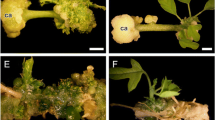Abstract
Callus cultures of Tabernaemontana persicariaefolia, (Apocynaceae), an endangered species endemic to the Mascarene Islands, were established from leaf explants on MS medium containing either 5 mg·l−1 2,4-D and 0.5 mg·l−1 BA or 5 mg·l−1 2,4-D, 0.5 mg·l−1 BA and 200 mg·l−1 DFMO. Histological studies showed regenerating nodules resembling globular embryos in calli after 4 weeks on the DFMO medium. Green shoot formation was achieved by sequential subculture of the induced calli on media with gradually decreasing 2,4-D concentrations (5→1→0 mg·l−1). Regeneration was greatly stimulated in the presence of DFMO. The first emergence of shoots occured 3 weeks earlier than in untreated callus cultures.
Similar content being viewed by others
Abbreviations
- BA:
-
6-benzyladenine
- 2,4-D:
-
2,4-Dichlorophenoxyacetic acid
- DFMO:
-
∝-difluoromethylornithine
- MS:
-
Murashige and Skoog (1962) medium
- NAA-1:
-
naphthaleneacetic acid
References
Amarasinghe V., Dhami R., Carlson J.E. 1996. Polyamine biosynthesis during somatic embryogenesis in interior spruce (Picea glauca x Picea engelmannii complex). Plant Cell Rep., 15: 495–499.
Anjani K. 1992. Somatic embryogenesis and high frequency plantlet regeneration in callus cultures of Thevetia peruviana. Plant Cell Tiss. Org. Cult., 31: 47–50.
Biggs A.R. 1984. Boundary-zone formation in peach bark in reponse to wound and Cytospora leucostoma infection. Can. J. Bot., 62: 2814–2821.
Bonneau L., Beranger-Novat N., Monin J., Martin-Tanguy J. 1994. Stimulation of root and somatic embryo production in Euonymus europaeus L. by an inhibitor of polyamine biosynthesis. J. Plant. Growth Regul., Accepted, in press.
Burtin D., Martin-Tanguy J., Carre M., Rossin N. 1990. Polyamines, hydroxycinnamoyl putrescines and root formation in leaf explants of tobacco cultivated in vitro. Plant Physiol., 93: 1348–1404.
Couillerot J.P., Decout E., Warnot F., Dubois J., Vasseur J. 1993. Evolution des polyamines libres en relation avec la source carbonée et l’embryogenèse somatique chez un Cichorium hybride. C.R. Acad. Sci. Paris, 316: 299–305.
Dupont J., Girard J.C., Guinet M. 1991. Tabernaemontana persicariaefolia. In: Flore en détresse, ed. by SREPEN, Ile de La Réunion, p. 41.
El Hadrami I., D’Auzac J. 1992. Effects of polyamine biosynthetic inhibitors on somatic embryogenesis and cellular polyamines in Hevea brasiliensis. J. Plant Physiol., 140: 33–36.
Fisher D.B. 1968. Protein staining of ribboned epon sections for light microscopy. Histochemie, 16: 92–96.
Grenand P., Moretti, Jacquemin H. 1987. Les Apocynacées. In: Pharmacopées Traditionnelles en Guyane, ed. by ORSTOM, Paris. 108: 114–122.
Hamama L. 1995. Micropropagation of jojoba (Simmondsia chinensis (Link) Schneider) via tissue culture. Development of two protocols for obtaining somatic embryos. Molecular characterization of the somatic embryogenesis competence. Thèse de doctorat, Université de Nantes, France, 219 pp.
van der Heijden R., Wijnsma R., Verpoorte R. Harkes P.A.A., Baerheim Svendsen A. 1986. The influence of nutrient media auxins and cytokinins on the initiation of alkaloid producing callus on leaf explants of eight species of Tabernaemontana. Fitoterapia, 57: 415–423.
Helleboid S., Couillerot J.P., Hilbert J.L., Vasseur J. 1995. Inhibition of direct somatic embryogenesis by ∝-difluoromethylarginine in a Cichorium hybrid: effects on polyamine content and proteins patterns. Planta, 196: 571–576.
Housti F., Coupé M., d’Auzac J. 1991. Facteurs enzymatiques du brunissement in vitro et capacité embryogène des cals d’Hevea brasiliensis. C.R. Acad. Sc. Paris, 313: 461–466.
Housti F., Coupé M., d’Auzac. J. 1992. Effect of ethylene on enzymatic activities involved in the browning of Hevea brasiliensis callus. Physiol. Plant., 86: 445–450.
Lapena L., Brisa M.C. 1995. Influence of culture conditions on embryo formation and maturation in auxin-induced embryogenic cultures of Digitalis obscura. Plant Cell Rep, 14: 310–313.
Loiseau J., Marche C. Le Deunff Y. 1995. Effects of auxins, cytokinins, carbohydrates and amino acids on somatic embryogenesis induction from shoot apices of pea. Plant Cell Tiss. Org. cult., 41: 267–275.
Maheswaran G., Williams E.G. 1985. Origin and development of somatic embryoïds formed directly in immature embryos of Trifolium repens, in vitro. Ann. Bot., 56: 619–630.
Markgraf F., Boiteau P. 1973. In: Les “Bois de lait” des îles Mascareignes ed. by Adansonia, 2: 241–248.
Murashige T., Skoog F. 1962. A revised medium for rapid growth and bioassays with tobacco tissue cultures. Physiol. Plant., 15: 473–479.
Nadolska Orczyk A., Orczyk W. 1994. New aspects of soybean somatic embryogenesis. Euphytica, 80: 137–143.
Nitsch J.P., Nitsch C. 1965. Néoformation de fleurs in vitro chez une espèce de jours courts Plumbago indica L. Ann. Physiol. Vég., 7: 251–256.
Preece J. E., Zhao J., Kung F.H. 1989. Callus production and somatic embryogenesis of white ash. Hortsciences, 24: 377–380.
Saudemont D. 1992. Assays of somatic embryogenesis in witloof chicory genotypes (Cichorium intybus L. var. Magdeburg x Cichorium endivia L. var. latifolia). 1992. Thèse de doctorat, Université de Lille, France, 120 pp.
Schwendiman J., Pannetier C., Michaux-Ferricre N. 1990. Histology of embryogenic formations during in vitro culture of oil palm Elaeis guineensis Jacq. Oléagineux, 45: 409–418.
Sharma P., Rajam M.V. 1995. Spatial and temporal changes in endogenous polyamine levels associated with somatic embryogenesis from different hypocotyl segments of eggplant (Solanum melongena L.). J. Plant Physiol., 146: 658–664.
Sierra M.I., van der Heijden R., Schripsema J., Verpoote R. 1991. Alkaloid production in relation to differentiation in cell and tissue cultures of Tabernaemontana pandacaqui. Planta Med., 57: 543–547.
Sierra M.I., van der Heijden R., van der Leer T., Verpoote R. 1992. Stability of alkaloid production in cell suspension cultures of Tabernaemontana divaricata during long-term subculture. Plant Cell Tiss. Org. cult., 28: 59–68.
Sihachakr D., Cavalcante-Alves J. M. Tizroutine S., Allot M., Mussio I., Servaes A., Nzoghé D., Ducreux G. 1994. Embryogenèse somatique chez la patate douce (Ipomea batatas (L) Lam.): caractérisation et régénération des plantes. In: Quel avenir pour l’amélioration des plantes? Ed. AUPELF-UREF, John Libbey Eurotext. Paris: 251–261.
Author information
Authors and Affiliations
Rights and permissions
About this article
Cite this article
Kodja, H., Robene-Soustrade, I. & Figier, J. Synergistic effect of DFMO and 2,4-D on regeneration of Tabernaemontana persicariaefolia jacq in vitro . Acta Physiol Plant 19, 359–366 (1997). https://doi.org/10.1007/s11738-997-0013-x
Received:
Accepted:
Issue Date:
DOI: https://doi.org/10.1007/s11738-997-0013-x




